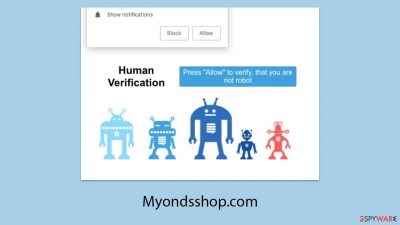Myondsshop.com ads (fake) - Tutorial
Myondsshop.com ads Removal Guide
What is Myondsshop.com ads?
Myondsshop.com is a malicious website you should steer away from and never interact with its requests

Web surfers may occasionally find themselves at Myondsshop.com, sometimes without even realizing it, which plays into the hands of its scam operation. This site ingeniously entices its visitors with a pop-up prompt that asks them to press an “Allow” button. This simple request, which appears harmless, is actually a gateway for the site to start sending push notifications.
Once enabled, these notifications flood the user's screen with a variety of deceptive messages. These can range from false alerts about virus infections designed to cause panic, to bogus notifications of lottery wins designed to excite, or even scams promising quick and easy wealth. The links provided by Myondsshop.com are crafted to play on the user's emotions and lead them into risky situations that could involve phishing schemes, malware infections, or other cybercriminal activities.
Fortunately, there is a way out for those ensnared by Myondsshop.com. By simply adjusting the push notification settings in their web browser to block communications from this site, users can stop the intrusive alerts. Moreover, it's advisable to conduct a comprehensive scan for any potential malware that might have been installed as a result of engaging with these scams, ensuring a clean and safe digital environment.
| Name | Myondsshop.com |
| Type | Push notifications, ads, pop-ups, scam |
| Distribution | The unwanted activity starts at some point after the Allow button is pressed within the notification prompt |
| Symptoms | Pop-ups show up on a regular basis on the screen – these ads often include inappropriate, scam, phishing, or other similar content |
| Risks | Shown pop-ups incorporate fake notices and push scams. Links can also lead to websites filled with malware |
| Removal | To prevent the site from displaying notifications, access the site settings section via your web browser settings – we explain how to do that below. As a precautionary measure, we recommend checking the system for adware with SpyHunter 5Combo Cleaner |
| Other tips | We recommend using FortectIntego to fix any virus damage that might have occurred due to a system infection. The app can also remove various trackers for better privacy |
Push notifications can be used by scammers to push ads to earn ad revenue
Push notifications and pop-up ads represent two prevalent advertising techniques encountered across the web. While they might appear similar at first glance, both in form and function, their operational dynamics are markedly distinct, making it crucial for users to grasp their differences.
Pop-up ads manifest as separate windows or tabs that pop up to display advertisements when a user navigates to a website that hosts them. These ads are limited to the website that activates them, and users can typically bypass these intrusive pop-ups by either avoiding those specific websites or using pop-up blockers. The main aim of pop-up ads is to capture the user's attention towards a product, service, or other forms of commercial content, thereby generating revenue for the site.
Conversely, push notifications are built on a different foundation. They make use of the browser's push notification API (Application Programming Interface), allowing them to function beyond the confines of specific websites. Unlike pop-up ads that are visible only during a visit to the hosting site, push notifications can appear across various sites and even when the browser is closed, making them more persistent.
For instance, websites like Myondsshop.com exploit this capability to push advertisements, leading to instances where users may receive notifications at inopportune moments. This can be particularly disruptive when engaging in activities like watching videos or gaming in full-screen mode, with a browser running in the background, thus causing unexpected and often aggravating interruptions.
Although the end goal of both pop-up ads and push notifications is to generate advertising revenue by promoting commercial content, the manner in which they impact user experience is significantly different. Pop-up ads are site-specific and relatively easier to avoid, whereas push notifications are more pervasive, capable of appearing regardless of active web browsing, and are tied to the browser rather than any single website.
In essence, despite their superficial similarities, pop-up ads and push notifications operate through distinct mechanisms. Pop-up ads are confined to the websites that host them, while push notifications have the capacity to surface across a variety of websites, irrespective of whether the user is actively browsing or not.
The continuous nature of push notifications can lead to unanticipated interruptions, rendering them more intrusive and potentially more bothersome to users. Understanding these differences is key for users looking to navigate their online experience more smoothly and mitigate unwanted advertising.
Cheap but clever techniques
Scammers have crafted a sophisticated strategy utilizing push notifications to trick users, often by imitating well-known online behaviors. The scheme usually starts with an innocuous-looking prompt that encourages users to enable notifications.
These prompts are crafted to leverage users' trust and exploit their familiarity with common online interactions. Below are some of the most frequently used messages in these scams:
- The “Click Allow to confirm you're not a robot” prompt takes advantage of users' familiarity with human verification systems like captchas, lending the scam an air of legitimacy.
- The “If you are 18+, click Allow” message acts as a fake method for age verification. Since many reputable sites ask for age confirmation, this seems trustworthy to unsuspecting users.
- The “Click Allow to watch the video” prompt often shows a counterfeit video GIF poised to play or mimics the layout of a YouTube video, deceiving users into thinking they're about to view legitimate content.
- The “Click 'Allow' to win a prize and pick it up from our store!” message falsely promises lavish rewards through a sham giveaway, misleading users into believing they could win something when, in reality, no prizes exist.

By recognizing these manipulative strategies, individuals can better safeguard their online security and steer clear of falling prey to these push notification scams. Awareness of these tactics is a crucial step in maintaining vigilance and preventing deceitful entities from exploiting the established norms of internet engagement.
Removal of unwanted content
In our previous discussion, we highlighted how adware might lead to unwanted redirects to sites that bombard you with unsolicited notifications or engage in other deceptive practices. Due to their inconspicuous nature, these programs can remain hidden, silently operating in the background.
To thoroughly eliminate any potential malware or related harmful elements, we strongly recommend conducting a detailed system scan with reputable security software options SpyHunter 5Combo Cleaner or Malwarebytes. After identifying and removing any malicious software, it's crucial to use a reliable system repair tool such as FortectIntego to fix any damaged system files and remove browser trackers, thereby enhancing your online privacy.
Once you've cleaned your system of adware and any other hidden threats, you can address the issue of unwanted ads, such as those from Myondsshop.com, by adjusting your browser settings. It's important to understand that while security software is effective in removing malware, stopping push notifications requires you to manually block the specific URL through your browser's settings. We will provide step-by-step instructions on how to achieve this, ensuring you can enjoy a safer, ad-free online experience.
Google Chrome
- Open the Google Chrome browser and go to Menu > Settings.
- Scroll down and click on Advanced.
- Locate the Privacy and security section and pick Site Settings > Notifications.
- Look at the Allow section and look for a suspicious URL.
- Click the three vertical dots next to it and pick Block. This should remove unwanted notifications from Google Chrome.
![Stop notifications on Chrome PC 2 Stop notifications on Chrome PC 2]()
Google Chrome (Android)
- Open Google Chrome and tap on Settings (three vertical dots).
- Select Notifications.
- Scroll down to the Sites section.
- Locate the unwanted URL and toggle the button to the left (Off position).
![Stop notifications on Chrome Android Stop notifications on Chrome Android]()
Mozilla Firefox
- Open Mozilla Firefox and go to Menu > Options.
- Click on Privacy & Security section.
- Under Permissions, you should be able to see Notifications. Click the Settings button next to it.
- In the Settings – Notification Permissions window, click on the drop-down menu by the URL in question.
- Select Block and then click on Save Changes. This should remove unwanted notifications from Mozilla Firefox.
![Stop notifications on Mozilla Firefox 2 Stop notifications on Mozilla Firefox 2]()
Safari
- Click on Safari > Preferences…
- Go to the Websites tab and, under General, select Notifications.
- Select the web address in question, click the drop-down menu and select Deny.
![Stop notifications on Safari Stop notifications on Safari]()
MS Edge
- Open Microsoft Edge, and go to Settings.
- Select Site permissions.
- Go to Notifications on the right.
- Under Allow, you will find the unwanted entry.
- Click on More actions and select Block.
![Stop notifications on Edge Chromium Stop notifications on Edge Chromium]()
Internet Explorer
- Open Internet Explorer, and click on the Gear icon at the top-right of the window.
- Select Internet options and go to the Privacy tab.
- In the Pop-up Blocker section, click on Settings.
![Stop notifications on Internet Explorer Stop notifications on Internet Explorer]()
- Locate the web address in question under Allowed sites and pick Remove.
How to prevent from getting adware
Access your website securely from any location
When you work on the domain, site, blog, or different project that requires constant management, content creation, or coding, you may need to connect to the server and content management service more often. The best solution for creating a tighter network could be a dedicated/fixed IP address.
If you make your IP address static and set to your device, you can connect to the CMS from any location and do not create any additional issues for the server or network manager that needs to monitor connections and activities. VPN software providers like Private Internet Access can help you with such settings and offer the option to control the online reputation and manage projects easily from any part of the world.
Recover files after data-affecting malware attacks
While much of the data can be accidentally deleted due to various reasons, malware is one of the main culprits that can cause loss of pictures, documents, videos, and other important files. More serious malware infections lead to significant data loss when your documents, system files, and images get encrypted. In particular, ransomware is is a type of malware that focuses on such functions, so your files become useless without an ability to access them.
Even though there is little to no possibility to recover after file-locking threats, some applications have features for data recovery in the system. In some cases, Data Recovery Pro can also help to recover at least some portion of your data after data-locking virus infection or general cyber infection.






